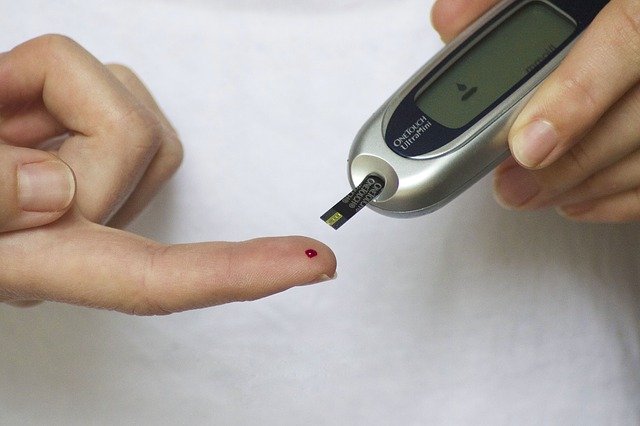The Science Behind Type II Diabetes: An easy way to understand this growing epidemic
To speak plainly—Type II diabetes is a rapidly growing epidemic; 26 Million Americans have it, and 79 million Americans have pre-diabetes. To put this more in perspective, 25% of all Americans over the age of 65 have Type II diabetes (ref 1), and about 1/10 of the people reading this article have it. Even scarier is the fact that many of these diabetics don't even know that they have it!
It is not a fun topic for many, and maybe it is personally depressing for those who have it; but it’s reality. It’s time for people to wake up to this harsh reality and take control of their lives.
90% of Type II diabetics are obese (ref 1), and one of the best ways to manage/rid oneself of it is through losing that weight.
In my first health post, I talked about the pathophysiology of Type I diabetes, a disease that I have had for over 13 years. I was going to make this post a (part 2), but I decided to make this a completely different post. We will cover the pathophysiology; however, I wanted to separate these diseases. In fact, these are completely different diseases with much different causes that result in one common thing: high blood sugar!
I am in my final year of medical school and hope to concentrate much of my efforts in diabetes management.
Let me start with a made-up story about Tom who loves pizza...
The Story of Tom: the man who loves pizza
Tom is a 55 year-old male who loves pizza—the more cheese, the better. He exercises a few days a week and enjoys, like many, the natural produce he grows in his yard. He eats his fruits and vegetables, and doesn’t trust “the doc” or any pill the doc wants to give him. He has no major diagnosed medical problems, except he is overweight. His mother and father died of heart attacks in the past 5 years, and his grandfather died from complications of diabetes.
He doesn’t feel that bad but has come to the doctor with complaints of nerve pain in his feet. He only notices it sometimes, and when he goes to bed, his feet feel “tingly.” The doctor asks him if he is thirsty... He replies that he does not notice it that much but defiantly likes to drink plenty of water and fresh fruit smoothies. His doctor gets some basic blood work and notices that his blood sugar is 209mg/dl (normal fasting sugar is around 70-80mg/dl), and has high cholesterol. His blood pressure is elevated at 141/91. His doctor tells him that he has Type II diabetes and will need to lose weight, lay off the pizza, and take a statin for his cholesterol and an ACE inhibitor for his blood pressure and kidney protection. In addition, he will prescribe him gabapentin for the nerve pain in his feet.
Tom is confused/sad and does not want to take anything. But he agrees to try to lose weight. His doctor also recommends that he starts metformin, a Type II diabetes medication, if he can not lose weight by the next visit.
Why did Tom get diabetes, and what is going on in his body to make his blood sugar a 100 points higher than it should be?
Although "medical professionals” and “scientists” don’t know have all the answers, this blog will go into what we do know to further help our understanding of this very common and deadly disease!
Type II Diabetes, why the heck is the blood sugar high?
In contrast to Type I diabetes, the disease I have where the body kills its own insulin producing cells in the pancreas, Type II diabetes is another beast unto itself. In contrast to Type I diabetes, Type II diabetics can initially have a very high production of insulin producing cells. Type II diabetics actually have plenty of beta-cells, insulin producing cells in the pancreas, but they are not as effective at lowering blood sugar. We call this insulin resistance.
Insulin resistance! Sounds freaky! … Well, it it. Let me explain.
Insulin resistance is when fat and muscle cells in your body don’t respond to insulin well. There are GLUT transporters on each of the fat and muscle cells in a person's body that need insulin to get the sugar out of the blood and into these cells.
In healthy people who consume a meal high in carbohydrates (whether from candy, fresh fruit, bread, or in Tom’s case, pizza!), those foods are broken down into “simple sugars” which flow in the blood stream. Insulin is released by the pancreas, which allows the GLUT transporter sitting on the cell membrane (lets call it a “door”) to be a passageway for the sugar to get out of the blood and into these important cells so that these cells can use that sugar for fuel. This allows the cells to be “fed” and the sugar in the blood to decrease to normal levels. The insulin is acting like the key to open this GLUT door
In a Type II diabetic with insulin resistance, this GLUT transporter door is “rusty". They require more insulin to push that GLUT transporter door open. The door still opens a little bit, so the fat and muscle cells still survive and can function, but they are not able to get much sugar through that door. So the sugar in the blood builds up leading to increased blood glucose (high blood sugar—AKA hyperglycemia).
Before the development of diabetes, almost all obese individuals have some level of “insulin resistance,” which means that is takes more insulin to open these GLUT transporters on cells. In other words, pre-diabetics have HIGH levels of insulin in the blood because the body “realizes" there is resistance and “tells" the pancreas to release more insulin. At first, the body is able to compensate pretty well by secreting more insulin and the blood sugar remains close to normal. However, over time the resistance becomes too great and the pancreas can’t secrete enough insulin to compensate for this insulin resistance. The demand is higher than the supply of insulin the pancreas can secrete. Overtime, and often years later, the pancreas also gets “tired” of secreting extra-insulin, which causes the pancreas to “burn out.”
When the pancreas "burns out” over years, the beta cells in the pancreas actually start dying. This leads to a Type II diabetic needing insulin injections for treatment of his or her condition permanently. If one's body can’t make enough insulin, then more will need to be injected in the skin. The obesity epidemic has increased dramatically in the past couple of decades, which can also lead to such severe insulin resistance that exogenous insulin may be needed earlier in the disease process. In these cases, if the patient loses weight, they may be able to stop insulin treatment if they can lower that resistance before the pancreas “burns out."
In addition to insulin resistance, a hormone called glucagon is also secreted more by the pancreas in Type II diabetics. Glucagon through various mechanisms on the liver, increases blood sugar. In normal individuals, this is important when the blood sugar becomes too low. It is also used as exogenous treatment for diabetics who become severely hypoglycemic (low blood sugar).
So why does a Type II diabetic secrete more glucagon when their blood sugar is high?….
There may be multiple reasons for this, some of which we may not understand fully. One easy way to conceptualize this is that although the blood sugar is high, the fat and muscle cells are not being “fed” enough sugar that is building up (trapped) in the blood so the body “thinks” that it is in a low glucose state. Therefore, more glucagon is released, and the blood sugar rises due to the liver secreting more of its stored sugar (glycogen).
Bottom Line:
Type II diabetics have increased blood sugar (glucose) due to many factors. Initially, they actually produce/secrete a lot of insulin (more insulin than a healthy individual without insulin resistance) to try and compensate for the high glucose levels. Insulin resistance is one of the main reasons they have trouble lowering blood sugar. Pre-diabetics have insulin resistance, but their blood sugar is only slightly elevated because the supply of insulin is still enough to match most of the demand. Once the pancreas becomes “overwhelmed” with the amount of supply needed to lower the blood sugar, the demand is too great, and the blood sugar rises. Over years, the pancreas gets “over-worked” and starts to “burn-out” and insulin producing cells die. This leads to low insulin levels with very high insulin resistance. Other factors like increased secretion of glucagon, further the increase in glucose levels.
What Causes Insulin Resistance!?
Obesity and genetics seem to be major causes for this phenomenon. There are multiple theories about how increased adipose tissue (fat cells) lead to this increase resistance. Whether these theories are 100% accurate or not is not a matter of much importance. The fact that 90% of Type II diabetics are obese, however, is. Let me put it this way, environment (over-eating) seems to be the strongest risk factor for developing this disease.
It is no wonder why this was not a common disease, and now it is one of the most common. It is sad that we have shows on TLC that embrace the large body lifestyle. I never judge a person for their personal life choices, but embracing the “big body can be healthy” is not a scientific statement at all. It is a statement of denial of major health issues, one being Type II diabetes. If people actually saw what I see every month in the hospital, I think their outlook would be different. I have seen people go blind, and I have seen these diabetics get their legs and toes amputated. Not a pretty site, especially when this diabetic epidemic could be significantly reduced by maintaining a healthy body weight.
I may release another post just on this issue because it is signifiant, and it is not spoken about enough. I don’t mean to go on a mini-rant, but I want to inspire people to know how to take control of their disease. It is not as simple as eating fresh fruit or eating vegetables. While these are good for you and can help you lose weight, it’s not the formula to managing diabetes. The formula is losing weight, and taking the necessary medications in the meantime until the resistance is decreased. Not to “look” like the model body, but simply to live a longer and higher quality life.
Theories of Why Fat Causes Insulin Resistance: I will mention 2 below (Ref 2)
- Adipose Tissue Blocks Glucose Uptake Into Muscle Cells
This is a very well supported theory. I have mentioned how GLUT transporters on muscle cells need insulin to open these channels so that glucose can get out of blood and into muscle cells. Fat simply makes this process harder. We can make a comparison to rust on a door. The GLUT transporter is the door, and insulin is the key to open that door. The fat is like the rust that can build up on a door making it harder for insulin to open that door. Therefore, more insulin is needed to break that door open. When a person gains more weight, the insulin they produce is not enough to open that door fully, and the sugar builds up on the other side of that door (the blood stream).
2. Decreased glycogen synthase activity and glycogenesis
I could make a whole post on the biochemistry of this process….but that would probably bore you to death! Essentially fat causes a decrease in sugar storage (glycogen) so less is stored and more is in the blood
Another major contributor to insulin resistance is GENETICS:
There have been many genes isolated that seem to correlate with insulin resistance (Ref 1). Not all over-weight individuals get diabetes (although the majority of over-weight individuals have at least a minor increase in insulin resistance whether their blood sugar levels are elevated or not). In some cases (around 10% of Type IIs), Type II diabetics will not be overweight. If a skinny/normal size diabetic has insulin resistance, then the genetics are so strong for insulin resistance, that weight is not the main culprit. However, if these “normal weight” diabetics gain an unhealthy amount of weight their resistance will still increase and more medication/insulin will be needed.
Genetics to the “common man” may seem a little bit confusing, and for diabetes much of it is confusing! It involves multiple genes unlike a disease like Cystic Fibrosis where the CFTR gene is generally involved. If one parent has Type II diabetes before the age of 50, each offspring has around a 1/7 chance of getting it (Ref 3). It is hard to get a great estimate of the genetic significance, but I believe many individuals have these multiple faulty genes. It is usually only revealed if the patient also has an unhealthy lifestyle (90% of the time).
In my story about Tom, he also had high cholesterol and blood pressure. There is a syndrome called “metabolic syndrome.” It is basically a syndrome of bad test results, including obesity, a bad cholesterol profile, high blood pressure, and more. This, to me, is more convincing of the significance these faulty genes play in all these manifestations.
Another way to think about this is if a doctor had a skinny patient who did not have diabetes, but did have high cholesterol and high blood pressure, they would be at increased risk of Type II diabetes due to these similarities in a genetic profile. It is helpful to study metabolic syndrome so that a doctor can be proactive instead of reactive to a disease process.
Before ending this discussion on the disease process of Type II diabetes, I wanted to share a little more about the story about Tom. Tom complained of nerve pain in his feet. Sadly, this may be the first presenting symptom in an individual with Type II diabetes. In fact, a Type II diabetic can have the disease for years without having symptoms. In Type I diabetes, the patient makes no insulin so the symptoms are always present and management is started almost immediately. Although Type II diabetics have an advantage over Type Is because Type IIs have insulin production in their body, they have the major disadvantage of finding the disease late!!! This is why if one is overweight and has risk factors for diabetes, they should be screened by a doctor for the disease. Some Type II diabetics may be thirsty, or urinating a lot, but often these classic symptoms are not present.
So which disease is worse: Type I or Type II diabetes?
I would say they are both bad but both have separate advantages and disadvantages. Type IIs have a major disadvantage in time to diagnosis, and usually already have an unhealthy life-style. On top of all this, the genetic profiles of Type II diabetics seem to be more linked to heart disease, which can decrease their lifespan as well.
After all this “negative”, there is still light at the end of the tunnel. Unlike Type I diabetics, there is a potential for Type II diabetics to rid themselves of high blood sugar without medication if it is caught early enough before the pancreas starts failing. It takes hard work, taking the proper medication, and most importantly losing weight.
I thank all of you for reading this important health post and look forward to discussing the complications of diabetes and maybe even the current management of the disease.
Feel free to comment, and I would be delighted to entertain any questions!
I strongly recommend people to read my first blog post on Type 1 diabetes to better understand these diseases:
*Some of the information has been “simplified” for the reader. For instance, in my storytelling fashion, I often act like the liver or other body parts are "thinking" to "prevent" something. This is an over-simplification and meant to help understand the various processes. More microbiology and biochemistry would have to be explained to understand this phenomenon (I did not want to bore you guys to death haha).
*Sources:
Ref 1) Medscape Reference on Type II diabetes: http://emedicine.medscape.com/article/117853-overview?pa=htUtmitmZ0ldWih%2Boe6NEnQsy0NIIa7r%2FFqM3gLLkTvfEruRBbkrFCTpQ60Aip4Ks0z4AKrvO%2FcCusdHa9eAWSchrzF%2F7vlnSF6AEX%2F09M8%3D#a3
*Ref 2) European review article on the pathophysiology of obesity induced insulin resistance: http://www.europeanreview.org/wp/wp-content/uploads/17.pdf
*Ref 3) Healthline statistics on Type II diabetes: http://www.healthline.com/health/type-2-diabetes/statistics
*Images: All images from Pixabay.com, and no sources are needed
...and a photo of me!









please enlighten everyone how diabetes is given to rats ... for lab tests... what do they do to induce it... ?
It depends on which type of diabetes. For type 1, I would assume the pancreas would be taken out or chemically killed so it would replicate type 1 diabetes. For rats used for the type 2 studies, they could be injected with faulty genetic genes. They could then feed them food and see if type 2 diabetes persisted in them. It really depends on the study design. .